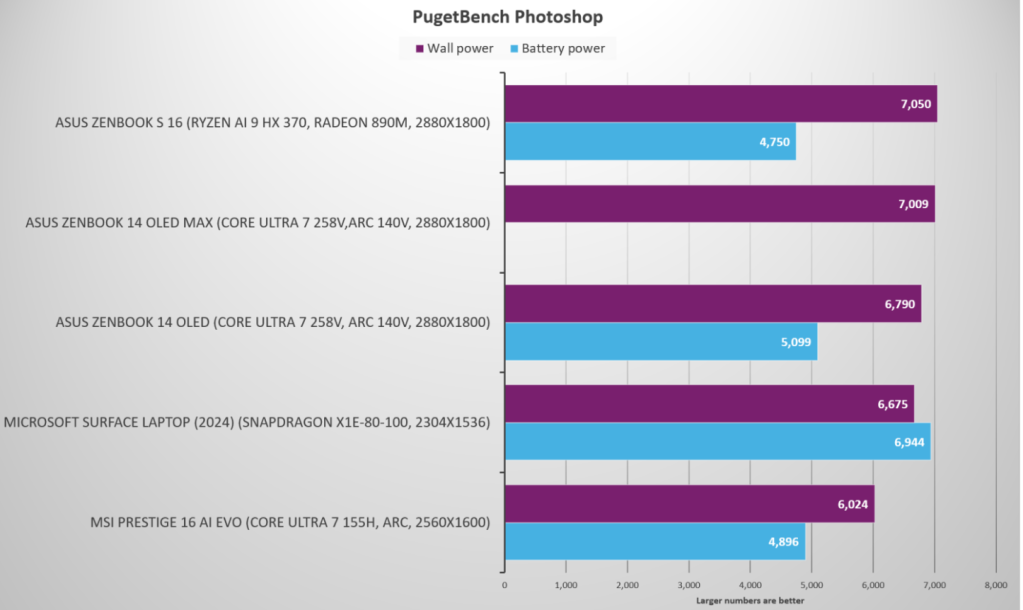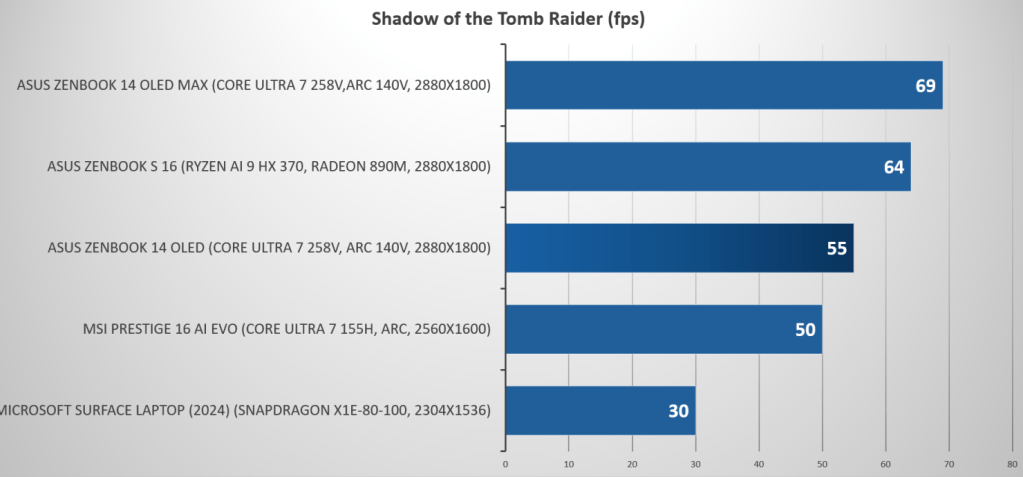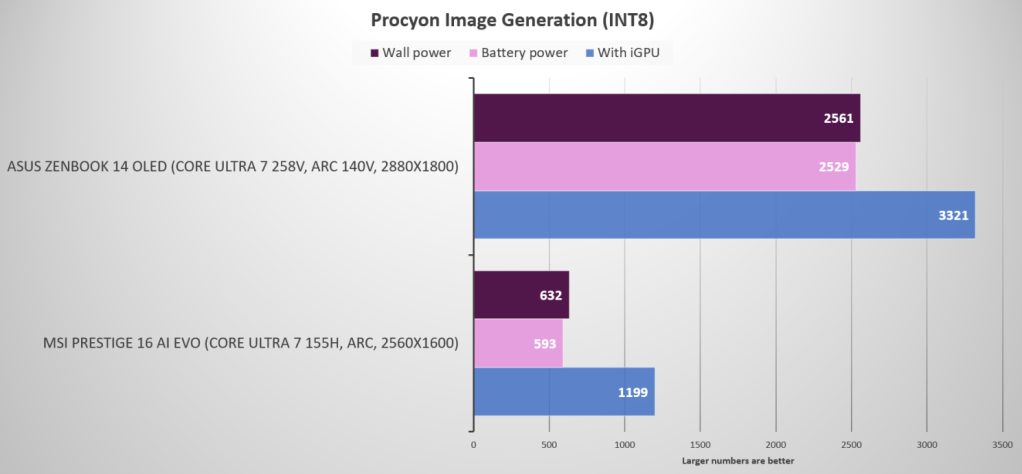Mark Hachman/IDG
This becomes a real problem in certain situations.
When you're working on the go, you rarely work at a consistent pace: one time you open a website, then you take a break from reading, then you write an email, take a sip of coffee, look at your smartphone… your laptop is often idle. But when you actually ask it to launch an application, the latest generation of mobile processors struggles to keep up.
In our latest tests of the AMD Ryzen AI 300, we adjusted our handbrake test to make it more demanding. Handbrake transcodes a video — in this case, the open-source film “Tears of Steel” — and that’s a computationally intensive process.
How well the notebook can cool itself plays a role, but so does the battery: performing this test can take almost an hour, and even a robust battery can fail in the process. I couldn't complete three of these tests in a row before the battery died, which equates to about three hours of demanding work.

Mark Hachman/IDG
Lunar Lake: Graphics and AI performance
Up to this point, Intel's Lunar Lake didn't seem particularly impressive compared to the competition. But now we turn to the integrated GPU and the new Xe2 graphics engine, which Intel says will later appear in a second discrete GPU codenamed Battlemage.
Given AMD's historical strength in GPUs, Intel's resurgence is somewhat surprising. But in two tests – Time Spy, an older benchmark aimed at desktop and mobile gaming, and its successor Steel Nomad Light – Intel's Lunar Lake shines.

Mark Hachman/IDG
Can you edit photos on the go? Puget Systems, a workstation developer, writes its own benchmarks to answer this question. The test uses a scripted benchmark to apply various filters and adjustments to images opened in Adobe Photoshop. The program then generated success from this.
Here all three mobile platforms are close together, probably indicating that all three are well suited to the task. Here's some additional context: According to the PugetBench website, an AMD Ryzen 7 7800X3D desktop system with a GeForce RTX 3080 achieves a score of 9,959. The MSI Raider notebook with an Intel Core i9-14900HX and a Geforce RTX 4090 laptop GPU also achieved a score of 9,959. And an Intel Core i7-9750H desktop PC with a Geforce GTX 1660 Ti manages at least 4,549 points.

Mark Hachman/IDG
We don't typically run gaming benchmarks on devices that are actually considered productivity calculators. But in this case, Intel has assured us that these devices are good enough for basic gaming, especially at low graphics settings. We had to try this!
Normally 60 frames per second is considered the minimum for good gameplay – anything less and the game can stutter unpleasantly. In our test, we tried Shadow of the Tomb Raider at 1080p resolution and low settings. The older feel of the game was very good and also looked appealing. All of our gaming tests were conducted with the power adapter connected.

Mark Hachman/IDG
After its disastrous launch, “Cyberpunk: 2077” has once again become one of the more playable games on the PC. The title also runs quite well on Lunar Lake. However, AMD's Ryzen is still better suited for this. These tests were also all carried out at 1080p resolution and with low settings. Frame generation was activated for the Ryzen processor; This is not offered for the other two chips.
Instead, “Cyberpunk” features XeSS resolution scaling, which allows for a playable frame rate of around 65 frames per second when Windows and laptop settings are booted to performance mode.

Mark Hachman/IDG
Finally we come to AI. Artificial intelligence has become one of the hottest topics in computing, although developers have not yet flooded the market with AI applications that run locally on the PC. The 24H2 update for Windows 11 is intended to enable more in this regard, including generative art for Paint and Photo.
At the moment there aren't too many benchmarks that test this performance. Keep in mind that Intel's Lunar Lake, AMD's Ryzen AI 300 (up to 50 TOPS), and Qualcomm's Snapdragon X Elite chips (45 TOPS) are all Copilot PC qualified, even if they don't get their new features without a Microsoft update become. Intel's Lunar Lake chips offer varying numbers of TOPS; The Core Ultra 258V, for example, delivers 47 TOPS.
UL's Procyon app measures this AI performance by then testing each chip to see how well it runs different AI frameworks. Like the Cinebench or 3DMark tests, the point is to get a general picture of how quickly the chips can perform AI functions.

Mark Hachman/IDG
While I don't have a Procyon result ready for the AMD Ryzen chip, the test shows that both Lunar Lake and the Snapdragon X Elite are pretty much on par; Intel's chip performs better at AI on the grid, but Qualcomm is the better AI chip on the go.
Procyon also offers a practical test: AI generative imaging, which uses AI to generate a series of eight images. However, this test does not yet run on ARM processors. I ran two tests to illustrate the practical performance of the NPU. First I used the test to create a series of 8 images using just the NPU. After that, I ran the same test with the support of the integrated GPU.
The test uses an 8-bit integer model, which produces less complex images than a floating point model. But the images are created quickly: around 8 seconds per image when the NPU and the iGPU are combined.

Mark Hachman/IDG
Lunar Lake: Performance and battery life
It's easy to measure a laptop's battery life. But things get complicated with this chip. How long your laptop lasts depends heavily on the size of the battery and how large and efficient your laptop's screen is. The type of screen (IPS or OLED) also makes a difference.
We compare previous test results of the Asus ZenBook S 16 (with a Ryzen AI 300 chip and a 78 watt-hour battery), the 13.8-inch Surface Laptop 7th Edition (with a Snapdragon X Elite chip and a 54 watt-hour battery ), the Asus Zenbook 14 OLED (with a first-generation Core Ultra Core 155H and a 75 watt-hour battery) and the current Asus Zenbook OLED (with its Lunar Lake chip and a 73 watt-hour battery) with each other.
To do this, we run a 4K video in a loop at a fixed screen brightness until the laptop battery is empty. The Lunar Lake notebook lasted for 21 hours. The result simulated a weekend camping trip or a longer sales conference.
However, when assessing the runtime, it makes much more sense to put a little more strain on the laptop in order to simulate a real working environment. UL's Procyon battery life test moves from office application to office application, performing specific “tasks” to simulate working on your laptop for hours.
Keep in mind that Meteor Lake, Lunar Lake, and the Ryzen AI tests were run in “balanced” mode, while the Snapdragon X Elite was left in its “recommended” power saving mode. We achieved at least 10 hours of computing power for all three competitors. This is fantastic!
- Intel Lunar Lake: 17 hours, 7 minutes
- Qualcomm Snapdragon X Elite: 16 hours, 20 minutes
- AMD Ryzen AI 300: 10 hours, 42 minutes
- Intel Meteor Lake: 10 hours, 35 minutes
Which laptop chip is better?
Older chip experts will remember Transmeta, a laptop processor startup that was able to translate its instruction set from x86, similar to ARM. Transmeta's legacy is not so much what the company achieved, but what it led Intel to do in the first place: to finally conquer the laptop market and develop a competitive laptop processor in the years of the new century.
Now it's that time again. Intel's first Core Ultra, Meteor Lake, reduced performance in favor of long battery life; Lunar Lake takes this to the next level.
Is Intel's Lunar Lake also a Snapdragon killer? Not quite. When it comes to efficiency, there's a lot to suggest that Qualcomm's Snapdragon X Elite is still the most efficient processor. However, AMD's Ryzen chips win in many performance-intensive tasks, but in return the battery life suffers.
But in some ways none of this matters in everyday life. A few grams more for the battery essentially “nullifies” Qualcomm’s advantage, as our test notebook from Asus proves. But the Snapdragon still outperforms it in various scenarios except gaming. Here, the ongoing compatibility issues related to the ARM instruction set and the impressive 3D engine give the Core Ultra Series 2 a solid advantage.
All apps work on Intel and AMD computers, but problems may still occur on Snapdragon laptops, even though Qualcomm has already managed to get many of the popular apps running on ARM.
The bottom line is that Intel's Lunar Lake is at best mediocre at all tasks that rely on the CPU. Once the GPU or NPU comes into play, things get better. The same applies to the battery life; Intel can keep up well with the Snapdragon here.
A few years ago, it was easy to determine the “best” notebook chip. Now the question is what is best for you. And there is no clear answer to this question: With Arrow Lake, which is already in the starting blocks, Intel could still have a real high-performance processor up its sleeve.
Our buying advice: The best laptops of all classes: premium, budget, gaming and 2-in-1
How we tested Intel's Lunar Lake
This test uses benchmarks compiled by myself, my colleague Gordon Mah Ung, and other laptop experts in current and previous testing. I focused on the three most important chips of this generation: Intel's Core Ultra Series 2/Lunar Lake, the Qualcomm Snapdragon X Elite and the AMD Ryzen AI 300.
The laptop provided by Intel and Asus contains a Core Ultra 7 258V. This is roughly in the middle of the Core Ultra Series 2 chips that Intel has brought to market. It's unusual that Intel doesn't provide us with its top chip for comparison testing. Because the Ultra 7 258V has four powerful cores, four energy-saving cores and a turbo clock of 4.8 gigahertz. All in all, there are only eight threads available for processing tasks.
The nice thing is that Intel and Asus have always used similar laptop models to compare between chip generations, most notably the Asus Zenbook 14 OLED, in both the Lunar Lake and the previous generation of Meteor Lake Core Ultra processors are installed. AMD is using the Asus Zenbook S 16 as the debut platform for the Ryzen AI 300.
While I tested the Microsoft Surface Pro (2024) on the Qualcomm site, I also grabbed the Surface Laptop 7 and ran some additional benchmarks with it. That's a fairer comparison for Qualcomm. For certain benchmarks, I used an MSI Prestige 16 AI Evo with an identical Meteor Lake chip for logistical reasons.
(PC World)



